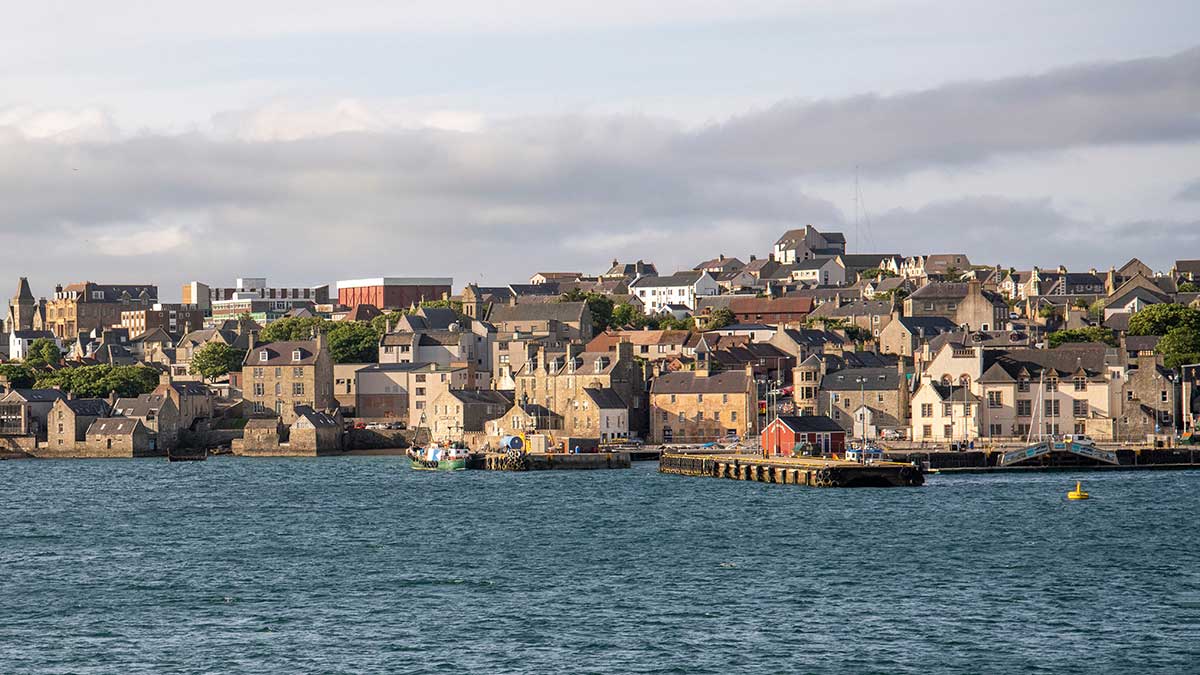As the holidays approach, we can learn much about planning a low-carbon holiday meal from the folks in Shetland’s Lerwick Harbor. There, the grey stone buildings stand close together. Houses line streets that march downhill in curving lines to meet the sea. They buttress against the cold winds that race across the northernmost fetch of the North Sea.
On the first Sunday of October, Saint Columba’s Church of Scotland is filled with people who bring food items, canned goods, and large cereal boxes. A fishing net is spread before the pulpit, holding paper cutouts of mackerel. Plastic fish trays, which look like shallow milk crates, are filled with food items brought forward and placed to the left and right of the net.
On Harvest Sunday, a woman leading the morning service spoke of mouse and man, the story of a field mouse surprised to find people with children assembled in the barn praising God for the harvest. They sang: “Touch the earth lightly, use the earth gently, nourish the life of the world in our care: gift of great wonder, ours to surrender, trust for the children tomorrow will bear.”
Carbon Trade-Offs
We also must touch the earth more lightly to quell the ravages of climate change and to cool the planet. The foods we choose to eat vary widely regarding the overall carbon emissions burdening the atmosphere. Beef cattle in feedlots are the worst. Thirty pounds of carbon dioxide are emitted to produce one pound of beef.
Pork is better at four to 12 pounds of carbon dioxide to produce one pound of protein. Value is added when pigs consume our food scraps that otherwise would rot and release methane. Chickens require three to six pounds, ten times less carbon dioxide than feedlot beef for a pound of protein.
A large portion of the world’s protein diet is fish. Shetland is located at the gateway to the finest Atlantic fishing grounds, including Faroe Bank and the Home Ground, second only to the Grand Banks off Newfoundland. Shetlanders were renowned for their skills in boat handling far out at sea and for salting and curing fish. They spared no expense for the finest salt. As a result, the Basque fishermen paid a premium to bring Shetland cod to their markets. When steam trawlers and drift nets were developed, Shetlanders pivoted to lead the herring fisheries, selling products to Eastern Europe.
The North Sea herring and the Grand Banks cod fisheries collapsed in the 1970’s. Today, the Shetland fishing fleet is much smaller. Crabs are plentiful. Lobsters are trapped, placed in boxes slightly larger than a lobster trap, and set again. Every other day, half on one day and half on the other, the lobster boxes are pulled on deck and a couple of mackerel or saith are placed inside to feed the lobsters.
Holiday Harvest
Large lobster harvests take place to stock up for the Christmas market in December. The lobsters get a respite during winter months. In February, the fishermen turn to trapping whelks, an edible sea snail, in five-gallon pots.
Two distant water cod-fishing smacks owned by the fishery company, A. Sandison and Sons, the Silver Lining and the Thomas Henry, were renowned for the size of their catches. Today, among other things, the company makes boxes in Lerwick for the salmon farming industry.
Dr. Frances Sandison, a Life Cycle Analyst at the James Hutton Institute in Aberdeen, completed a Ph.D. thesis assessing Shetland seafood consumption’s role in delivering smaller carbon footprints. Farmed salmon are the worst for the environment, at four pounds of carbon dioxide per pound of protein, due to the feed they receive. Modern pelagic mid-water trawl fleets that catch mackerel and herring produce an average of 0.5 pounds of CO2 emissions per pound of protein.
The most efficient seafood with the smallest carbon footprint is rope-grown farmed mussels, which account for a tiny 0.2 pounds of carbon dioxide per one pound of protein. A delicious way to eat mussels comes via Bermuda: Mussel pie has a golden-brown flakey pie crust filled with mussels, diced potatoes, finely chopped onion, fresh thyme, minced parsley, curry powder, and a dash of Worcestershire sauce. A dollop of mayonnaise inserted under the hot pie’s crust is optional.
Learn From History, Change The Future
Like the Shetland Islanders, we can develop ways to use more of the fish, resulting in more protein products and more value with less catch.
A climate-smart future features more seafood in our diet and moderation of high-carbon dioxide emitting less sustainable foods such as less soybeans and only pasture-rotated beef, more crab cakes, fish pies, and “chowdah.”
Together, let’s eat well to reduce our carbon footprints and “nourish the life of the world in our care.”
Dr. Rob Moir is a nationally recognized and award-winning environmentalist. He is president and executive director of Cambridge, MA-based Ocean River Institute, a nonprofit that provides expertise, services, resources, and information unavailable on a localized level to support the efforts of environmental organizations. Please visit www.oceanriver.org to learn about their work.
,
Source link
Earth911 earth911.com

